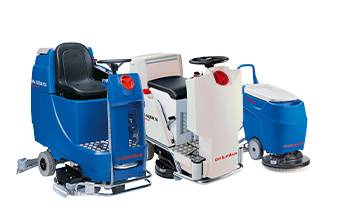Scrubber dryer is a mechanical device to make floors clean and dry professionally. This machine performs based on a brushing system, a suction system and separated water tanks. The Brushes rotate at a high speed, removing all tough contaminations sticking to the ground. As the brushes rotate, clean water is sprayed on the floor from the clean water tank.
Suction system includes rubber squeegee, suction engine and suction hose. Through it, the dirty water and the remaining dirt are collected by the squeegee which is embedded in the rear of the machine, and is sent into the dirty water tank through suction system. As a result, dust and debris are removed and the floor will look neat, shiny and dry.
Separate clean and dirty water tanks prevent transmission of contaminations from one place to another. Floor scrubber dryers are suitable and efficient to clean surfaces in commercial buildings, hospitals, schools, administration, industrial plants, factories and many other places.
The best scrubber driers are able to conserve energy which reduces the entire cost of cleaning using less water, increasing cleaning quality, working in an Eco-friendly style because of using less chemical material. Scrubber dryer is a user-friendly machine which lets any user utilize it easily and safely.
Scrubber dryers are reliable, powerful and safe. They are versatile and can clean all kinds of surfaces in various situations. Taking advantage of completely safe structures and functions, they can be used in environments with high hygienic sensitivity and standards of cleaning safely.
Depending on how large the area is, maneuver power, environmental features and the level of hygiene needed in different places, the manufacturers have produced two kinds of industrial floor scrubber dryers: walk-behind and ride-on scrubbers; this allows operators to use scrubber driers in all types of places, in every position.
Different types of Floor scrubber dryer
Distinctions in size, maneuver power, environmental features and the level of hygiene which is needed in different places, magnifies the necessity of using appropriate floor scrubber dryers. The efficiency of a floor scrubber dryer in a specific place depends not only on the width of the squeegee or the capacity of its tanks, but also on features like how it is guided around the floor or the power source. Choosing the right device can ensure reaching the level of hygiene we wish to get to. The floor scrubber dryers, therefore, can be categorized according to the criteria mentioned below. It must be considered that the design, and capacity of floor scrubber dryers affect their price.
The way the floor scrubber dryer is guided around the floor affects the dimensions of the machine and consequently the width of cleaning, capacity of the tanks, the energy which is spent on the side of the operator and finally the output. Industrial floor scrubber dryers are divided into two groups.
walk-behind floor scrubber dryer
In this type, the operator stands behind the floor scrubber dryer and pushes it ahead, guiding it to the appropriate direction. These floor scrubber dryers are usually designed and produced in small sizes and space saving designs and therefore are applicable to small and medium- sized spaces such as passages. The compact size of machines of this type is considered an advantage when they are used in cramped spaces with several obstacles such as a class. walk-behind operated floor scrubber dryer have a complementary role when cleaning large spaces.
ride-on floor scrubber dryer
ride-on floor scrubber dryer is a more efficient type of industrial cleaning machines in which a space has been designed for the operator while guiding the machine. The amount of energy spent by the operator while working with the machine is reduced to a large degree while the output is remarkably raised. The design of the ride-on floor scrubber dryer provides the machine with the advantage of cleaning larger spaces and holding bigger tanks. In case the space permits using either type, using ride-on floor scrubber dryer is both more economical and more efficient.
Different types of floor scrubber dryer in terms of power source
The type of power source influences mechanical features and maneuver power of the machine to large extent. Other qualities like the existence of a ramp, ease of access to electrical outlets, and appropriate air conditioning while cleaning must be taken into account. Floor scrubber dryers are divided into two types in terms of power source.
Floor scrubber dryers operating with mains power
Electricity is considered as a clean, pollution – free, and reliable power source which due to its ease of access, cost effectiveness, and non- polluting nature is most often considered as the main power source of floor scrubber dryers. Since industrial floor scrubber dryers are almost used indoors, they will make no kind pollution or smoke. Electric motors supplying energy work either on battery or are mains powered. Thus, the mains powered floor scrubber dryers are divided into battery – powered or electrical squeegees. In battery – powered machines, limitations caused by trailing cables or the necessity of access to electrical outlets are already removed. On the other hand, mains powered floor scrubber dryers, which need to be consistently connected to a power source never run out of battery and their more powerful electrical engines, in comparison with similar battery- powered floor scrubber dryers, leads to more effective vacuuming and cleaning. With regard to the environment and the type of use walk-behind floor scrubber dryers have, they are possible to be manufactured in mains-powered or battery- operated form. However, due to electrical outlet access limitations, ride – on floor scrubber dryers are supplied only in battery – operated forms.
Fossil fuels operated machines
In case of any restrictions in access to electrical power sources, or a need to more powerful machines for industrial environments with a high level of pollution, there will be a call for industrial floor scrubber dryers that operate on fossil fuels like gasoline, diesel and LPG.














